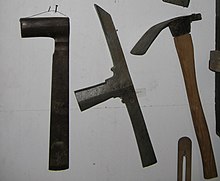
From the left to right: (1) Stichaxt or Stoßaxt, German-style mortise axe; (2) Kreuzaxt, medium-sized twybil (smaller than the larger French besaiguë; usually fitted with a short wooden handle); and (3) adze

A twybil is a hand tool used for green woodworking.[1] It is used for chopping out mortises when timber framing, or making smaller pieces such as gates.[1] It combines chopping and levering functions in a single tool.
The appearance of a twybil is that of a T-shaped double-edged axe with unusually long blades and a very short handle. This appearance is deceptive, as they are actually derived from a large double-ended chisel with a side handle added for better control. The geometry of a twybil, particularly the long straight blades, makes it unworkable as an axe. Unfortunately many old examples have been damaged by such misuse. The related mortising axe is similar, but single-sided and is forged and tempered to survive the shock loads of swinging as an axe.[2]
Twybils always have two working ends and these are always different. The first is an axe-like blade, with the edge arranged parallel to the handle. The second edge is crossways, as for an adze. This is used for prying and levering rather than cutting.
- ^ a b Abbott, Mike (1998). Green woodwork. Guild of Master Craftsman. p. 189. ISBN 0-946819-18-1.
- ^ Mercer (1925), p. 175.